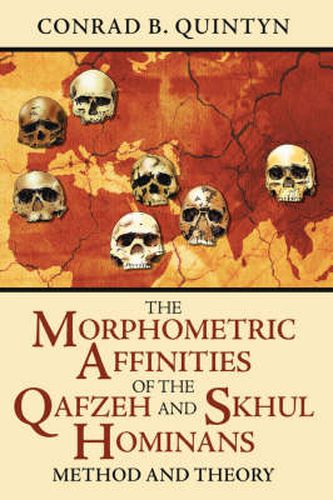Readings Newsletter
Become a Readings Member to make your shopping experience even easier.
Sign in or sign up for free!
You’re not far away from qualifying for FREE standard shipping within Australia
You’ve qualified for FREE standard shipping within Australia
The cart is loading…






This title is printed to order. This book may have been self-published. If so, we cannot guarantee the quality of the content. In the main most books will have gone through the editing process however some may not. We therefore suggest that you be aware of this before ordering this book. If in doubt check either the author or publisher’s details as we are unable to accept any returns unless they are faulty. Please contact us if you have any questions.
In the arguments on modern human origins the Qafzeh-Skhul hominans, based on skeletal analyses, are accepted as “anatomically modern” and given the lofty title of “Proto-Cro-Magnons.” However, their modernity has been questioned in the literature. In this research, 42 dimensions were measured on the craniofacial bones of Qafzeh, Skhul, Cro-Magnons, Neanderthals, and other archaic, early, and recent modern samples from Africa, Western Asia, Europe, and East Asia (total crania, N=400) to test the null hypothesis that the Qafzeh-Skhul hominans are ‘Proto-Cro-Magnons.’ An alternate hypothesis was also tested: the Qafzeh and Skhul hominan samples have morphometric affinities to one, some or none of the regional sample groups in this research. Canonical variate analysis based on log size/shape and shape D2 for male and female craniofacial data show quite clearly that the Qafzeh and Skhul hominan samples are distant from the Cro-Magnons but closer to African and Levantine (Middle Eastern) sample groups. Hierarchical cluster analysis presented similar results.Based on the data in this research, the hypothesis stating that the Qafzeh and Skhul hominans are “Proto-Cro-Magnons” is rejected. Instead, the alternate hypothesis is accepted: the Qafzeh and Skhul hominans have strong morphometric affinities to archaic and early modern Africans and Levantines. Together, the Qafzeh-Skhul skeletal sample shows strong evidence of mosaic evolution. In essence, are the Qafzeh and Skhul hominans descendants of “the” modern African population that left the continent 200,000 to 150,000 years ago according to the mitochrondrial DNA genetic evidence? This is certainly possible. Are the Qafzeh and Skhul hominans ancestors of the later Cro-Magnons who, supposedly, “replaced” all existing, well-adapted populations in the Old World–even the remarkable Neanderthals–by 30,000 years ago? According to the craniofacial data in this research, the answer is no.
$9.00 standard shipping within Australia
FREE standard shipping within Australia for orders over $100.00
Express & International shipping calculated at checkout
This title is printed to order. This book may have been self-published. If so, we cannot guarantee the quality of the content. In the main most books will have gone through the editing process however some may not. We therefore suggest that you be aware of this before ordering this book. If in doubt check either the author or publisher’s details as we are unable to accept any returns unless they are faulty. Please contact us if you have any questions.
In the arguments on modern human origins the Qafzeh-Skhul hominans, based on skeletal analyses, are accepted as “anatomically modern” and given the lofty title of “Proto-Cro-Magnons.” However, their modernity has been questioned in the literature. In this research, 42 dimensions were measured on the craniofacial bones of Qafzeh, Skhul, Cro-Magnons, Neanderthals, and other archaic, early, and recent modern samples from Africa, Western Asia, Europe, and East Asia (total crania, N=400) to test the null hypothesis that the Qafzeh-Skhul hominans are ‘Proto-Cro-Magnons.’ An alternate hypothesis was also tested: the Qafzeh and Skhul hominan samples have morphometric affinities to one, some or none of the regional sample groups in this research. Canonical variate analysis based on log size/shape and shape D2 for male and female craniofacial data show quite clearly that the Qafzeh and Skhul hominan samples are distant from the Cro-Magnons but closer to African and Levantine (Middle Eastern) sample groups. Hierarchical cluster analysis presented similar results.Based on the data in this research, the hypothesis stating that the Qafzeh and Skhul hominans are “Proto-Cro-Magnons” is rejected. Instead, the alternate hypothesis is accepted: the Qafzeh and Skhul hominans have strong morphometric affinities to archaic and early modern Africans and Levantines. Together, the Qafzeh-Skhul skeletal sample shows strong evidence of mosaic evolution. In essence, are the Qafzeh and Skhul hominans descendants of “the” modern African population that left the continent 200,000 to 150,000 years ago according to the mitochrondrial DNA genetic evidence? This is certainly possible. Are the Qafzeh and Skhul hominans ancestors of the later Cro-Magnons who, supposedly, “replaced” all existing, well-adapted populations in the Old World–even the remarkable Neanderthals–by 30,000 years ago? According to the craniofacial data in this research, the answer is no.